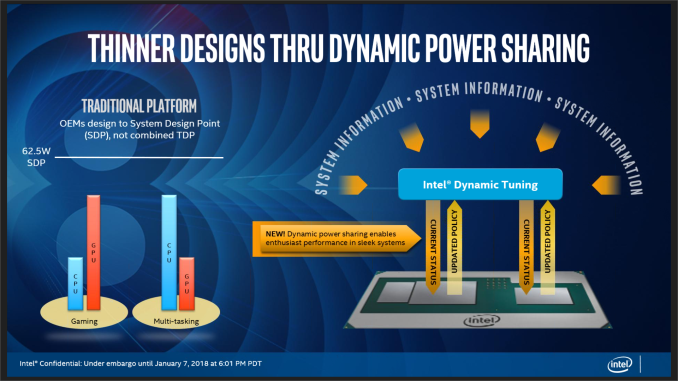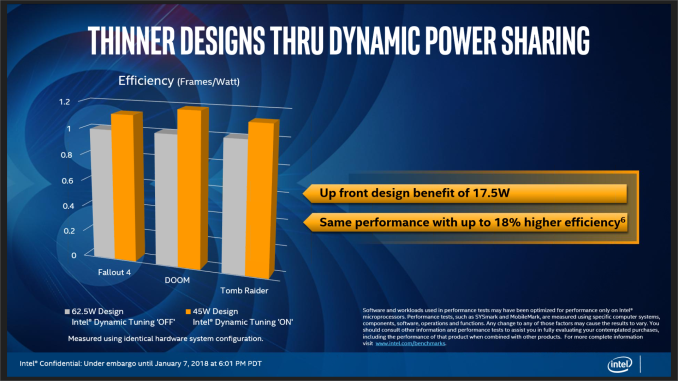Intel Core with Radeon RX Vega M Graphics Launched: HP, Dell, and Intel NUC
by Ian Cutress on January 7, 2018 9:02 PM ESTNavigating Power: Intel’s Dynamic Tuning Technology
In the past few years, Intel has introduced a number of energy saving features, including advanced speed states, SpeedShift to eliminate high-frequency power drain, and thermal balancing acts to allow OEMs like Dell and HP to be able to configure total power draw as a function of CPU power requests, skin temperature, the orientation of the device, and the current capability of the power delivery system. As part of the announcement today, Intel has plugged a gap in that power knowledge when a discrete-class graphics processor is in play.
The way Intel explains it, OEMs that used separate CPUs and GPUs in a mobile device would design around a System Design Point (SDP) rather than a combined Thermal Design Power (TDP). OEMs would have to manage how that power was distributed – they would have to decide that if the GPU was on 100% and the SDP was reached, how the CPU and GPU would react if the CPU requested more performance.
Intel’s ‘new’ feature, Intel Dynamic Tuning, leverages the fact that Intel can now control the power delivery mechanism of both the combined package, and distribute power to the CPU and pGPU as required. This leverages how Intel approached the CPU in response to outside factors – by using system information, the power management can be shared to maintain minimum performance levels and ultimately save power.
If that sounds a bit wishy-washy, it is because it is. Intel’s spokespersons during our briefing were heralding this as a great way to design a notebook, but failed to go into any sort of detail as to how the mechanism works, leaving it as a black box for consumers. They quoted that a design aiming at 62.5W SDP could have Intel Dynamic Tuning enabled and be considered a 45W device, and by managing the power they could also increase gaming efficiency up to 18% more frames per watt.
One of the big questions we had when Intel first starting discussing these new parts is how the system deals with power requests. At the time, AMD had just explained in substantial detail its methodology for Ryzen Mobile, with the CPU and GPU in the same piece of silicon, so it was a fresh topic in mind. When questioned, Intel wanted to wait until the official launch to discuss the power in more detail, but unfortunately all we ended up with was a high-level overview and a non-answer to a misunderstood question in the press-briefing Q&A.
We’re hoping that Intel does a workshop on the underlying technology and algorithms here, as it would help shine a light on how future Intel with Radeon designs are implementing their power budgets for a given cooling strategy.












66 Comments
View All Comments
Hixbot - Sunday, January 7, 2018 - link
Pigs just flew.tipoo - Sunday, January 7, 2018 - link
I'm pretty confident we'll see this in the 15" rMBP. If you remember Iris Pro which Apple nearly single handedly asked Intel for, I can see them being the ones to push for this as well.Wonder if that means a redesign, if not even just more batteries in the same space would be nice, or more room for cooling. And, cough, SD card. Most likely none of that, but the move up from the meager 80GB/s feeding the current GPUs would go a long way, even aside from the extra execution resources.
tipoo - Sunday, January 7, 2018 - link
That, uh, was meant to be a new comment.Comments, but editable.
nico_mach - Monday, January 8, 2018 - link
Based on the TDPs and looking around at the market, they seem tailor made for VR work on imacs, possible mac minis (though I think that line is dead as soon as the stock is sold off).willis936 - Monday, January 8, 2018 - link
Not even Tim Cook's Apple is crazy enough to put a 65W part in a 15" laptop. Hopefully at least.tyaty1 - Monday, January 8, 2018 - link
It is less than the combined TDP of CPU and the dGPU on the latest MBP.WinterCharm - Monday, January 8, 2018 - link
The MacBook Pro's current TDP is 87W.I'm amazed that they top out at 85ºC and barely throttle. It's kind of insane.
cditty - Sunday, January 21, 2018 - link
Actually, the 15" throttles a whole lot if you do anything 'Pro' with it. When I do video encodes, it begins slowing down after the first 10 solid minutes or so. I love the machine, the build, the look, BUT, you are wasting money if you get a CPU above the base, because you are rarely going to get full speed under sustained load. If they move to this model and can actually maintain speed, I will most certainly upgrade. The Kaby Lake MBP has been a disappointment to me.skavi - Monday, January 8, 2018 - link
You have to realize that we're already well past that point. There's a 45W CPU and 35W GPU in the current MacBook Pro.lefenzy - Monday, January 8, 2018 - link
The 15" rMBP ships with an 89W charger. So only the 65 W solutions would work here.